| Image search results - "POT" |

Struck under Caligula. Nero and Drusus Caesars riding right, cloaks flying, NERO ET DRVSVS CAESARES / C CAESAR AVG GERMANICVS PON M TR POT around S-C. Rome mint, c. AD 37-38. RIC I 34 (pg. 110).socalcoins
|
|

TIBERIUS - As - 35/36 AD - Mint of Rome
Obv.: TI CAESAR DIVI AVG F AVGVST IMP VIII
Laureate head left
Rev.: PONTIF MAXIM TRIBVN POTEST XXXVII S C
Winged caduceus
g. 10,7 mm. 25,8
Cohen 22, RIC 59, Sear RCV 1771Maxentius
|
|

CARUS - Potin Tetradrachm - Year 1 - 282/283
Ob.: Î Î Î Î ÎÎΡÎC CEB; laureate, draped & cuirassed bust right
Rev.: L A; Dikaiosyne stg. left, holds scales and cornucopia
gs. 7,6 mm. 19
Milne 4660 Maxentius
|
|

DIOCLETIAN - Potin Tetradrachm - year 2 (285/286)
Ob.: A K Î ÎÎ¥ÎÎ ÎÎÎÎÎÎΤÎÎÎÎC CEB; laureate & draped bust right
Rev.: L B; Alexandria stg. left, holds bust of Serapis and sceptre
gs. 6,7 mm. 19,8
Milne 4781Maxentius
|
|

MAXIMIANVS - Potin Tetradrachm - Year 3 - 289/290 AD
Ob.: Î Î Î Î ÎΥΠÎÎÎÎÎÎÎÎÎC CEB; laureate & draped bust right
Rev.: L Î; Nike walking right holds wreath and palm
gs. 6,4 mm. 19,9
Milne 4818Maxentius
|
|

PROBVS - Potin tetradrachm - Year 3 - 279/280
Ob.: A K M ÎΥΡ ΠΡÎÎÎC CEB; laureate, draped and cuirassed bust right
Rev.: L Î; Tyche stg. left holds rudder and cornucopia
gs. 7,9 mm. 19,4
Milne 4583Maxentius
|
|

CARINVS - Potin tetradrachm - year 1 - 283 AD
Ob.: A K M A KAΡÎÎÎC K; laureate and cuirassed bust right
Rev.: L A; Tyche stg. left holds rudder and cornucopia
gs. 7,9 mm. 17,5
Milne 4667Maxentius
|
|

DIOCLETIAN - Potin tetradrachm - Year 3 - 286/287
Ob.: A K Î OYA DIOKLHTIANOC CEB; laureate and draped bust right
Rev.: ETOYC Î; Nike walking right holds wreath and palm
gs. 7,8 mm 19,6
Milne 4857Maxentius
|
|

Claudius II - Potin Tetradrachm - Year 2 (269/270)
Ob.: AVT K ÎÎÎVÎÎÎC CEB; Draped & cuirassed bust right
Rev. L B; Eagle right, head right; palm branch left
gs. 10,3 mm. 21,1
Milne 4291Maxentius
|
|

Aurelian - Potin tetradrachm - 274/275
Ob.: A K L DOM AVRHLIANOC CEB; laureate, draped and cuirassed bust right
Rev.: ETOVC S; Eagle stg. right with wreath in her beak and palm branch
Gs. 8,2 mm. 21
Emmett 3927, Milne 4448Maxentius
|
|

GERMANICVS - As minted under Caligula - 40/41 AD
Obv.: GERMANICVS CAESAR TI AVGVST F DIVI AVG N, bare head left
Rev.: C CAESAR DIVI AVG PRON AVG P M TR POT IIII P P around large SC.
Gs. 11 mm. 29,1
Cohen 4 RIC 50
Maxentius
|
|

MARCVS AVRELIVS - Denarius - Minted under Antoninus Pius -148/149 A.D.
Obv.:AVRELIVS CAESAR AVG PII F, bare head right
Rev.: TR POT III COS II, Minerva standing right, holding spear & hand resting upon shield.
Gs. 3 mm. 18,5
Cohen 618, RIC 438b (Pius) Maxentius
|
|

HADRIAN - Dupondius - 118 AD
Obv.: IMP CAESAR TRAIANVS HADRIANVS AVG, radiate and draped bust right;
Rev.: PONT MAX TR POT COS II. In ex. FORT RED / S C, Fortuna std. left holding rudder and cornucopiae
Gs. 13,2 mm. 26,8
Cohen 757var, RIC 557varMaxentius
|
|
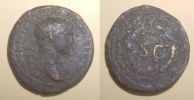
TRAJAN - Semis - Mint of Antioch - 115/116 AD.
Obv.: IMP CAES NER TRAIANO OPTIMO AVG GERM, radiate draped bust right
Rev.: DAC PARTHICO P M TR POT XX COS VI P P around SC within oak wreath.
Gs. 4,6 mm. 20,7
RIC 645, Cohen 123.Maxentius
|
|

Antoninus Pius - AE Dupondius
Roman Empire
Emperor Antoninus Pius. 138 - 161 AD. AE-Dupondius. Rome Mint.
obv: ANTONINVS AVG PIVS P P IMP II - Radiate head of Antoninus Pius right
rev: TR POT XIX COS IIII - Annona seated right, holding cornucopia; at feet, modius.
'S C' below, in exergue.
25.83mm, 11.80g.rexesq
|
|

Antoninus Pius - AE Dupondius
Roman Empire
Emperor Antoninus Pius. 138 - 161 AD. AE-Dupondius. Rome Mint.
obv: ANTONINVS AVG PIVS P P IMP II - Radiate head of Antoninus Pius right
rev: TR POT XIX COS IIII - Annona seated right, holding cornucopia; at feet, modius.
'S C' below, in exergue.
25.83mm, 11.80g.rexesq
|
|

Manuel I. AE Tetarteron. Thessalonica mint. QGE to left, P-over-w GIOS (or O GEORGIOC) to left or QGE to left, WGIOC to right of bust facing of St. George, unbearded, nimbate, wearing tunic, cuirasse and cloak, holding spear and shield / MANVHL DECPOTH (or MANOVHL DEC), crowned, unbearded bust facing of Manuel, wearing loros, holding labarum and cross on globe. SB 1975, BMC 75-77.
1,6 gr. 15mm.Antonivs Protti
|
|
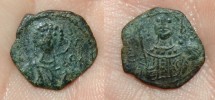
Manuel I, Comnenus. 1143-1180 AD. AE 1/2 Tetarteron, Greek Mint, 1.2 grams. AE14. (As SB1975 but much smaller). P-over-w GIOC to left of bust facing of St. George, unbearded, nimbate, wearing tunic, cuirass and cloak, holding spear and shield / MANVHL DECPOTH (or MANOVHL DEC), crowned, unbearded bust facing of Manuel, wearing loros, holding labarum and cross on globe. SB 1980, BMC 78.
1.0 gr. 11mm.Antonivs Protti
|
|

Manuel I, AE Tetarteron, 1143-1180 AD, Thessalonica. MANVHL DECPOTH, Manuel, crowned and wearing loros, bust facing, holding labarum and cross on globe / barred IC - barred XC to left and right of cross with X at centre, on three steps. SB 1976, BMC 86-90. SB 1976
2,3 gr. 18 mm.Antonivs Protti
|
|

Manuel I. AE Tetarteron. Thessalonica mint. QGE to left, P-over-w GIOS (or O GEORGIOC) to left or QGE to left, WGIOC to right of bust facing of St. George, unbearded, nimbate, wearing tunic, cuirasse and cloak, holding spear and shield / MANVHL DECPOTH (or MANOVHL DEC), crowned, unbearded bust facing of Manuel, wearing loros, holding labarum and cross on globe. SB 1975, BMC 75-77.
2,2 gr. 16mm.Antonivs Protti
|
|

AR denarius (3.02 gm).
T CAES [IMP VESP] PON TR POT, laureate, draped and cuirassed bust right / NEP RED (N retrograde), Neptune standing left, right foot on globe, with acrostolium and sceptre. Antioch mint, struck AD 72-73.
RIC II.1, 1561 (see note 81); BMCRE II, 516; RSC II, 122; RPC II, 1933.
From the Harry Sneh collection.
socalcoins
|
|

Deutschland
Potsdam
Medaille 1924 (Bronze)
II.Preis , gestiftet vom Potsdamer Schwimmclub
Vs.: Schwimmer greifen nach Lorbeerkranz, den Germania hält
Rs.:Gravur
Gewicht: 16,3g
Durchmesser: 35mm
Erhaltung: vorzüglich _591Antonivs Protti
|
|

AUGUSTUS
AE As Rome Mint
25.7 mm, 10.3 grams
OBV: CEASER AUGUST PONT MAX TRIBVNIC POT, Bare head of Augustus right
REV: M MAECILIVS TVLLVS III VIR A A A F around large S C.
RIC-I-435
|
|

TRAJAN
Dupondius 98-99 A.D.
26.3mm, 9.3 grams
OBV: IMP CAES NERVA TRAIAN AVG GERM PM,
Emperor radiate head right.
REV: TR POT COS III PP, Abundance seated left on chair formed of two cornucopiae, holding scepter.
RIC-II-398
|
|

Caligula. 40-as; Caligula; 37-41 AD, Rome, 39/40 AD, As, 11.10g. BM-59, Paris-105, C-28, RIC-47 (S). Obv: C CAESAR DIVI AVG PRON AVG P M TR P III P P Head bare l. Rx: VESTA S - C Vesta seated l. holding patera and slanting scepter. Scarce with this date; most surviving VESTA asses date from Caligula\'s first tribunician year, with TR POT in obverse legendpaul1888
|
|

Roman Empire,
Titus Denarius
C. 69-79 AD
Reverse: TR POT VIII COS VII, Quadriga left bearing flower.
Centrally struck with good metal, surfaces and detail.
Ref: RIC 1073
Weight: 3.52g
paul1888
|
|
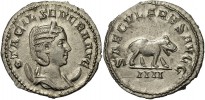
Otacilia Severa, Augusta, February or March 244 - September or October 249 A.D.
|Otacilia| |Severa|, |Otacilia| |Severa,| |Augusta,| |February| |or| |March| |244| |-| |September| |or| |October| |249| |A.D.|, From the issue celebrating the 1000th anniversary of the founding of Rome. Celebrations included display of many exotic animals including, it seems, a hippopotamus.
RS76152. Silver antoninianus, RIC IV P116b, RSC IV 63, Hunter III 10, SRCV III 9160, Choice EF, near perfect centering and strike, much luster, excellent portrait, 4th officina, Rome mint, weight 4.040g, maximum diameter 22.6mm, die axis 180o, 248 A.D.; obverse OTACIL SEVERA AVG, draped bust right, wearing stephane, hair in horizontal ridges, plait up the back of head, crescent behind shoulders; reverse SAECVLARES AVGG (Secular games [provided by] the Emperors), hippopotamus standing right, IIII (4th officina) in exergue; Ex Forum Ancient Coinspaul1888
|
|

Augustus à Dupondius. Struck 16 BC, C Cassius Celer, moneyer. CAESAR AVGVSTVS TRINVNIC POTEST, three lines in wreath / C CASSIVS CELER IIIVIR AAAFF around large S C. Cohen 409.Britanikus
|
|

VISHNUKUNDIN: "Sri", 6th century, potin unit (5.08g), Pieper-3031 (this piece), Mitch-177, bull right, Brahmi letter sri above // conch between lamps; excellent example! EF, ex Wilfried Pieper CollectionQuant.Geek
|
|

Marcus Aurelius. Silver Denarius (3.62 g), as Caesar, AD 138-161. Rome, under Antoninus Pius, AD 148/9. AVRELIVS CA-ESAR AVG PII F, bare head of Marcus Aurelius right. Reverse: TR POT III COS II, Minerva standing right, holding inverted spear and grounded shield. RIC 444; BMC 683; RSC 618. Lightly toned.
From The Herbert & Aphrodite Rubin Collection; Ex Seaby Coin and Medal Bulletin, October 1975, Lot A-805.paul1888
|
|

Otacilia Severa, Augusta, 244-249. Sestertius (Orichalcum, 23 mm, 15.68 g, 12 h), Rome, 248. MARCIA OTACIL SEVERA AVG Diademed and draped bust of Otacilia Severa to right. Rev. SAECVLARES AVGG / S C Hippopotamus walking right. Cohen 65. RIC 200a.paul1888
|
|

Antoninius Pius, RIC II 967, 138-161 CE
Antoninius Pius AE Sestertius
Obverse: ANTONINVS AVG PIVS P P IMP II, laureate head right.
Reverse: TR POT XX COS III S C, Securitas seated on chair formed by two cornucopia, holding sceptre and resting left arm on the top of one of the cornucopia.
30.5 mm., 21.7 g.NORMAN K
|
|

2nd - 1st Century BC, IRON AGE BRITAIN, Tribe: Cantii, AE Potin, Minted between 100 and 30 BCObverse: No legend. Crude outline of head facing right; pellet within circle in centre.
Reverse: No legend. Crude lines representing a bull facing left, crescents above.
Flat Linear type, Class 1
Found, Thames Valley region, England
Diameter: 17mm | Weight: 1.9gms | Axis: 3h
BMC: 667-714 | SPINK: 63
The Cantii produced the first coins to be actually made in Britain.
These coins were cast in strips which were then cut into separate coins and as a result often retain characteristic cut edges from the runlets which joined them together.
THE CANTII (or Cantiaci)
The Cantii (after whom Kent and Canterbury are named) were the major tribal group in the South East region of England, bordered by the Atrebates, Regni and Catuvellauni.
This region was heavily influenced by continental cultures on the periphery of the early Roman world and this resulted in the Cantii producing the first coins actually made in Britain. These are known as âpotinsâ and they were produced between the mid 2nd to the mid 1st century BC. The earliest versions are known as Kentish Primary, or Thurrock, types. Comparatively the later types, like those from the recently discovered Hillingdon Hoard, are of the âflat linearâ type, which uses simplified and abstracted images. Similar coins from the late Iron Age have been found, but in much smaller quantities.
The word âpotinâ is of French origin and is used to describe these early coins which were cast in clay moulds from a copper alloy with a high tin content. They would have been shiny and silver-coloured when new, and though occasionally examples have turned up which retain this colouration, most coins by the time they get dug up have a characteristic black patina from tin oxidation. These were cast in strips which were then cut into separate coins and as a result often retain characteristic cut edges from the runlets which joined them together. The moulds themselves were made using âmasterâ matrices of copper alloy which were cast with the design for one side of a coin in high relief and pressed into the clay. A rare example of a mould of this type was found a few miles west of the Surrey border in Hampshire.
The designs of the majority of potins found in England derive ultimately from coins produced in the Greek colonial Mediterranean city of Massalia (modern Marseilles) in southern Gaul in the late 4th century BC. These coins featured a head of Apollo on the obverse and a charging bull on the reverse. They were originally imported from the continent and later locally copied in the mid 2nd century BC, in the form of what are known as âThurrockâ types, which adhere closely to the original design. Later forms, known as âflat linearâ types, greatly simplified this design into deep abstraction, ultimately reducing the head of Apollo to an outline and the bull to a trapezoidal arrangement of lines
We donât know what these coins were called by the people who made them, or what they were worth in fiscal terms, but they are generally only found in south east England, which probably reflects the limits of the political and economic influence of the Cantii themselves. It isn't even clear what the role of these Iron Age coins actually was, though it is likely that they assisted in the maintenance of some kind of social power structure. Coins were not generally used as day to day currency by the people of Britain in the 1st and 2nd centuries BC, so apart from any monetary transactions, their range of uses probably included the storage of wealth, use as political tribute, and / or votive objects used as offerings to the gods.
CLICK ON MAP BELOW TO ENLARGE IT
 *Alex *Alex
|
|

Nicephorus I w/Stauracius AE follisObverse: Bust of Nicephorus facing, with short beard, wearing crown and
loros, and holding cross potent; to l., N; to r., I/K/H.
Reverse: Facing bust of Stauracius, beardless, wearing crown and chlamys,
and holding globe cross; to l., C; to r., T/A/V
Mint: Syracuse
Date: 803-811 CE
20mm/15mm; 2.76g
SBVC 1612;DOC 11wileyc
|
|

2 Augustus AE AsAugustus AE As
6 BC
Moneyer Sextus Nonius Quinctilianus
CAESAR AVGVST PONT MAX TRIBVNIC POT, bare head right / SEX NONIVS QVINCTILIAN IIIVIR AAAFF around large SC.
Cohen 474, RIC 439, Cohen 474, BMC 237
RI0008Sosius
|
|

3.5 DrususDRUSUS CAESAR
à As. Struck under Tiberius, 21-22 AD.
DRVSVS CAESAR TI AVG F DIVI AVG N, bare head left / PONTIF TRIBVN POTEST ITER around large Sâ¢C.
Cohen 2, RIC 45 (Tiberius), Cohen 2, BMC 99 VG/aF
RI0034Sosius
|
|

Nicephorus I w/Stauracius AE follisObverse: Bust of Nicephorus facing, with short beard, wearing crown and
loros, and holding cross potent; to l., N; to r., I/K/H.
Reverse: Facing bust of Stauracius, beardless, wearing crown and chlamys,
and holding globe cross; to l., C; to r., T/A/V
Mint: Syracuse
Date: 803-811 CE
19mm/15mm; 2.53g
SBVC 1612;DOC 11wileyc
|
|

1 AugustusAugustus
AE As. 7 B.C., P. Lurius Agrippa, moneyer
CAESAR AVGVST PONT MAX TRIBVNIC POT, bare head right / PLVRIVS AGRIPPA IIIVIR AAAFF around large SC.
RIC 427. C 445. Sear â88 510Sosius
|
|
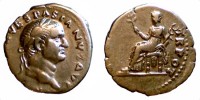
10 Vespasian Denarius, 70 ADVESPASIAN
AR Denarius, 70 A.D.
O: IMP CAESAR VESPASIANVS AVG, laureate head. r.
R: COS ITER T R POT, Pax seated left, holding branch and caduceus.
Sear 2285, RIC 29, RSC 94h
RI0058Sosius
|
|
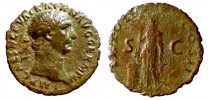
14 Trajan TRAJAN
AE As
IMP CAES NERVA TRAIAN AVG GERM P M, laureate bust right / TR POT COS II S-C, Pietas standing left by lighted altar, right hand raised.
Cohen 613, RIC 392
sear5 #3240
RI0112Sosius
|
|

14 Trajan AE AsTRAJAN
AE As
IMP CAES NERVA TRAIAN AVG GERM P M, laureate head right / TR POT COS IIII P P, Victory walking left, carrying shield inscribed S P/Q R.
Cohen 640, RIC 434
RI0113Sosius
|
|

14 Trajan AE AsTRAJAN
AE As. 98-99 AD.
IMP CAES NERVA TRAIAN AVG GERM P M, laureate head right / T R POT COS II P P S-C, Victory walking left, holding palm-branch & shield inscribed SPQR.
Cohen 617, RIC 402
RI0124Sosius
|
|

15 HadrianHadrian. A.D. 117-138. AE sestertius. Rome mint, struck A.D. 119.
Hadrian. A.D. 117-138. AE sestertius (35.51 mm, 26.94 g, 7 h). Rome mint, struck A.D. 119. IMP CAESAR TRAIANVS HADRIA-NVS AVG P M TR P COS III, laureate, bare-chested "heroic" bust right, drapery on left shoulder / PROVIDENTIAE DEORVM S - C, Hadrian, togate, standing facing, head left, right hand receiving scepter borne by eagle descending from sky on left and scroll (?) in left hand. RIC 589; BMC 1203. good VF/VF, fantastic sensitive portrait on heroic bust, green patina with spots of red, particularly on reverse. Ex Agora Auctions 5/9/2017Sosius
|
|

15 Hadrian SestertiusHADRIAN
AE Sestertius
IMP CAESAR TRAIANVS HADRIANVS AVG, laureate bust right / PONT MAX TR POT COS III, Felicitas standing, head left, holding corn ears & cornucopia
RIC 563a, Cohen 1192, Sear'88 #1119
RI0097Sosius
|
|

16 AeliusAELIUS
à As. Rome mint.
(26mm, 10.09 g, 6h). Struck under Hadrian, 137AD
Bare head right / Salus seated left feeding serpent rising from altar.
RIC II 1075 (Hadrian). Near EF, green patina, rough spot before Aeliusâ neck.
Ex CNG
RI0074Sosius
|
|

17 Antoninus PiusANTONINUS PIUS
AR Denarius.
ANTONINVS AVG PIVS P P, bare head right / TR POT COS II, modius with grain-ears & poppy.
RSC 874a RIC 58
RI0078Sosius
|
|

18 Marcus Aurelius - as CaesarMARCUS AURELIUS
as Caesar
AR Denarius.
AVRELIVS CAES ANTON AVG PII F, draped bust right / TR POT XI COS II, Virtus standing left with parazonium & spear.
RSC 721, RIC 473[pius], sear5 #4793
RI0103Sosius
|
|

18 Marcus Aurelius - as CaesarMARCUS AURELIUS
As Caesar
AR Denarius.
AVRELIVS CAES ANTON AVG PII F, draped bust right / TR POT XI COS II, Virtus standing left with parazonium & spear.
RSC 721, RIC 473[pius], sear5 #4793
RI0104Sosius
|
|

19 Lucius VerusLUCIUS VERUS
AE As
IMP CAES L AVREL VERVS AVG, laureate head right / FORT RED TR POT III S-C, COS II in ex, Fortuna seated left with rudder & cornucopia
RIC 1351 Fine
RI0100Sosius
|
|

19 Lucius Verus SestertiusLUCIUS VERUS
AE Sestertius (25.2g 33/32mm)
Rome Mint. Struck 162-163 AD
IMP CAES L AVREL VERVS AVG, bare head right / TR POT II COS II S-C, Fortuna seated left with rudder & cornucopiae, FORT RED in ex.
RIC III Verus 1318. Cohen 88. Sosius
|
|

29.6 Aquilia Severa - Wife of ElagabalusEGYPT, Alexandria. Aquilia Severa. Augusta, AD 220-221 & 221-222. Potin Tetradrachm (23mm, 11.63 g, 11h). Dated RY 4 of Elagabalus (AD 220/1). Draped bust right / Homonoia standing left, right hand raised, holding double cornucopia with left; L ̉ (date) to left. K̦ln 2369; Dattari (Savio) 4178; K&G 58.3. Near VF, dark brown patina, light porosity.
Ex CNG eAuction 318Sosius
|
|

3 Trajan DeciusTrajan Decius
AE20, Edessa, Mesopotamia
O: AVG DEKIC CEB. Radiate bust of Decius, R.
R: KOL EDICCA. Turreted bust of Cybele, l.
Babylon 103, BMC 168
Thanks to Helvetica for translating Babylon, without which I would not have been able to attribute this coin.Sosius
|
|

30 Severus Alexander and Julia MamaeaSEVERUS ALEXANDER & JULIA MAMAEA
AE27, Edessa, Mesopotamia
Confronting portraits of Severus Alexander and Julia Mamaea / City-goddess seated left, holding small temple; River-god swimming beneath her
SGI 3390 Sosius
|
|

317 - 337, CONSTANTINE II as Caesar, AE3 struck 321 at Londinium (London), EnglandObverse: CONSTANTINVS IVN N C. Radiate and cuirassed bust of Constantine II facing left.
Reverse: BEATA TRANQVILLITAS. Altar, inscribed VOT IS XX in three lines, surmounted by cosmic globe with three stars above; across field, P - A; in exergue, PLON.
Diameter: 20mm | Weight: 2.9gms | Die Axis: 6h
RIC VII : 219
Rare
Ex Killingholme Hoard (1993)
Claudius Constantinus was the eldest son of Constantine and Fausta, he was given the rank of Caesar in A.D.316, at the same time as Crispus and Licinius II.
This coin was struck in connection with the fifteenth anniversary of Constantine II's father, Constantine the great.
THE KILLINGHOLME HOARD
The Killingholme Hoard was discovered in a field between Killingholme and Habrough on the south bank of the Humber Estuary by a pair of metal detectorists in the Autumn of 1993.
The initial coins of the hoard were surface finds, many of which were found before the hoard itself was discovered. In total, there were 1504 coins found in the topsoil, and another 2753 found buried in a single clay pot.
The top of the pot had been cut off by ploughing, which had caused a large number of coins to be scattered around the field. Nevertheless, the remains of the pot were found when the coins packed in it were detected. The pot had a diameter of about 20cm and within it were thousands of coins.
One of the finders reported that the coins appeared to have been carefully arranged inside the pot, and seemed to produce a spiralling pattern. Unfortunately, the coins were emptied into a bath for cleaning so any chance of researching this arrangement was lost forever.
The coins that constituted the hoard were bronze reduced folles, most of which were struck between the 320s and the early 330s, during the time of the emperor Constantine. Though the coins came from several mints in the Western part of the Roman Empire, most of them were from the London mint. It is thought that the hoard was probably deposited around 333/334 AD.
Because, in 1993, base metal coins were not counted as treasure, the coins were returned to the finders who sent the bulk of the coins to be auctioned off by Spink of London. Fortunately, prior to being sold, the coins were recorded by the British Museum which acquired for itself 86 coins from the hoard.
After the recordings were completed, though the finders kept a few coins for themselves, the remainder of the coins were sold off in batches. It has been rumoured that many of these coins went to the Italian luxury goods producer Bulgari, who used them to make jewellery.
Such a process would not be permitted in England today as, following the enactment of the Treasure Act in 1996, the Killingholme Hoard would now fulfil the criteria for "treasure" as outlined by the Act.
CONTEMPORARY PHOTO OF THE KILLINGHOLM HOARD, CLICK ON THUMBNAIL TO ENLARGE IT
 *Alex *Alex
|
|

69bVespasian 69-79 AD
AR denarius
Obv "IMP CAESAR VESPASIANVS AVG"
Laureate bust left
Rev "TR POT X COS VIIII"
Figure (Octavian?) on rostral column
Rome mint
RIC 120mauseus
|
|

7 GallienusGALLIENUS
AE Antoninianus, Milan Mint
O: GALLIENVS AVG, Radiate bare bust right with wavy base, slight traces of drapery
R: ORIENS AVG, Sol standing l., holding whip, right hand raised, P in ex
Göbl 1211c Milan (S)
RIC 494 var (bust type)
VF, flat spot on reverse
Sosius
|
|

98Trajan 98-117 AD
AE sestertius
Obv "IMP CAES NERVA TRAIAN AVG GERM PM"
Laureate bust right
Rev "TR POT COS II PP SC"
Concordia seated left holding pater a and cornucopia
Rome mint
RIC 388mauseus
|
|

Antoninus Pius 138 â 161 CESilver denarius, RIC III 276, RSC II 1037, Rome mint, 2.4g, 16.8mm, 157-158 CE.
Obverse: ANTONINVS AVG PIVS P P IMP II, laureate head right.
Reverse: TR POT XXI COS IIII, Aequitas standing left holding balance and cornucopia.
Rome MintNORMAN K
|
|

Augustus AE As, C Cassius Celler SCAugustus (27 BC â 14 AD)
AE As, Rome, 16 BC. Issued by C. Cassius Celler
Obv. CAESAR AVGVSTVS TRIBVNIC POTEST. Bare head rigth.
Rev. C CASSIVS CELER III VIR A A A F F arround SC.
RIC 376
Weight: 7.7g.
Diameter: 27mm.
Jose Polanco
|
|
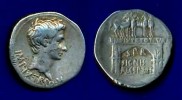
AUGUSTUS. AR Cistophorus (3 denarii) of Pergamum. Struck c.19 - 18 B.C.Obverse: IMP IX TR PO V. Bare head of Augustus facing right.
Reverse: Triumphal arch surmounted by Augustus in facing triumphal quadriga; IMP IX TR POT V on architrave; S P R SIGNIS RECEPTIS in three lines within arch opening, standards at either side.
RIC I : 510 | BMC : 703 | RSC : 298.
This coin commemorates Augustus' triumphant agreement with the Parthians in 20 B.C. under which they returned the legionary standards captured from Crassus who was defeated and killed at Carrhae thirty-three years earlier (53 B.C.) Augustus installed these standards in the Temple of Mars Ultor.
The reverse of the coin shows the triumphal arch which was awarded to Augustus on the occasion of his recovery of the standards. This was the second triumphal arch awarded to Augustus and, like the earlier arch which had been constructed in 29 BC to honour his victory over Cleopatra, this second arch, which archaeological evidence suggests may actually have incorporated the first arch, stood in close proximity to the Temple of Divus Julius at the southern entrance to the Roman Forum.
This is the rarest cistophorus struck during the reign of Augustus with the exception of the exceedingly rare issues featuring a sphinx.*Alex
|
|

Bulgaria, Second Empire: Iakov Svetoslav, Despotes in Vidin (1263-1275) Ã Trachy (Raduchev & Zhekov 1.5.3)Obv: Facing bust of St. Dimitrii, holding cross
Rev: Half-length facing bust of Iakov Svetoslav, holding sword and shield
Dim: 28mm, 2.97 g, 6hQuant.Geek
|
|

Kassander, 317 - 297 BC. AE18. Struck 319 - 305 BC at an uncertain mint in MacedoniaObverse: No legend. Head of Herakles, wearing lion's skin, facing right.
Reverse: KAΣΣAN - ÎPOY, above and below crouching lion facing right, Î in right field, before lion.
Diameter: 17.77mm | Weight: 3.76gms | Die Axis: 6
SNG Cop 1138 | Sear GCV 6753 | Forrer/Weber 2161
This type was issued before Kassander's assumption of the royal title in 305 BC
Kassander (Cassander) was one of the Diadochoi, a group of Macedonian generals, and the self proclaimed ruler of Macedonia during the political turmoil following the death of Alexander the Great in 323 BC. He was the son of Antipater, who had been appointed as regent in Macedonia while Alexander was in the East.
In 319 BC and close to death, Antipater transferred the regency of Macedonia to Polyperchon. Kassander refused to acknowledge the new regent and, with the aid of Antigonus I Monopthalmus the ruler of Phrygia, he seized Macedonia and most of Greece, including Athens. In 317 BC, he declared himself regent and had Alexander's widow, Roxanna and son, Alexander IV confined in Amphipolis. Later, in 310 or 309 BC, he had them put to death by poisoning. But, even though he had murdered Alexander's heirs and had been the de facto ruler of Macedonia from 317 BC, Kassander did not take the royal titles and declare himself king until 305 BC.
Meanwhile, Antigonus was intent on reuniting Alexander's empire under his own sovereignty and so Kassander joined forces with Ptolemy I of Egypt, Seleucus in Babylon and Lysimachus ruler of Thrace to oppose him. The two sides fought several battles between 319 and 303 BC resulting in Kassander losing Athens in 307 BC and his possessions south of Thessaly between 303 and 302 BC. However, in 301 BC Antigonus was defeated and killed at the Battle of Ipsus in Phrygia which allowed Kassander to secure undisputed control over Macedonia.
During his rule Kassander restored peace and prosperity to the kingdom, founding or restoring numerous cities, including Thebes which had been levelled by Alexander as punishment for rebelling against him. He also founded Thessalonica, naming the city after his wife, and Cassandreia, founded upon the ruins of Potidaea, which was named after himself.
Kassander died of dropsy in 297 BC and may have been buried in a royal tomb recently discovered at Vergina, identified as Aigai, the first Macedonian capital.
*Alex
|
|

Roman Imperial Coinage Trajan, AD 98-117.Sestertius 114-116, A 28.4 g. IMP CAES NER TRAIANO OPTIMO GER DAC P M TR P COS VI P P Laureate and draped bust r. Rev.
Trajan seated r. on platform placed on I., accompanied by two officers, addressing six soldiers, holding standards; in exergue,
IMPERATOR VIN/ S C. Rare. A very interesting reverse composition finely detailed on a full flan. Lovely untouched black patina with a few minor encrustations and green spots, 5/5 extremely fine
Private collection of Mr. B. MazehBrahim M
|
|

Trajan: Augustus 98-117 AD Trajan âheroic bustâ AR Denarius
Denomination: AR Denarius
Year: Autumn 116-August 117 AD
Bust: Laureate âheroicâ bust right, wearing aegis, with bare chest showing
Obverse: IMP CAES NER TRAIAN OPTIM AVG GERM DAC
Reverse: PARTHICO P M TR P COS VI P P S P Q R
Type: Felicitas standing left, holding caduceus and cornucopiae
Mint: Rome
Weight & Measures: 3.41g; 19mm
RIC: RIC 333
Provenance: Ex Michael Kelly Collection of Roman Silver Coins; Ex CNG, E-sale 99, Lot 623 (10/13/2004).
Translation: OB: Imperator Caesar Nerva Trajan Optimus Princeps Augustus, Germanicus, Dacicus; for Emperor Caesar Nerva Trajan, The most perfect prince, Augustus, Conquerer of the Germans and Daicians.
Translation: Rev: Parthicus, Pontifex Maximus, Tribunicia Potestate, Consul VI, Pater Patriae, Senatus Populusque Romanus; for Conquer of the Parthians, High Priest, Tribune of the Roman people, Consul for the 6th time, Father of his country, as recognized by the senate and the people of Rome.
Notes: Felicitas, Roman goddess of good luck. Justin L1
|
|

Tiberius. AD 14-37
à As (26mm, 9.14 g, 12 h)
Gaul? Imitating Rome mint issue struck AD 21-22
[TI CAESAR DIV]I AVG F AVGVST IMP [VII or VIII]
Bare head right
PONT[IF MAXIM TRIBVN] POTEST XXXIIII
Livia seated right, holding patera and long scepter; SC flanking
Cf. Cohen 19
The authors of RIC I do not recognize this type as being official. Cohen likely saw a similar imitation, assuming it to be an original mint issue.Ardatirion
|
|

EAST AFRICA, Kilwa Sultanate. Suleyman bin al-Hasan. AH 702-717 / AD 1302-1316
à Fals (23mm, 2.06 g, 11 h). Kilwa Kisiwani mint.
Inscription in two lines; star at center
Inscription in three lines
Album 1183; Walker, Kilwa 3; SICA 10, 602-11; Zeno 87052 (this coin)
Acquired in the 1960's, likely through circulation in Dar-es-Salaam.
The dating is adapted from Chittick ("On the Chronology of the sultans of Kilwa" in NC 13, 1973) - Bosworth (The New Islamic Dynasties) gives different dates. However, considering the uncertain nature of both the chronologies and how they relate to the coinage, particularly in light of the finds at Songo Mnara, all dates should be considered hypothetical.Ardatirion
|
|

EGYPT, Memphis
PB Tessera (24mm, 5.76 g, 11 h)
Nilus reclining left on hippopotamus, holding cornucopia and reeds, being crowned by Euthenia advancing right
Isis-Hekate triformis standing facing, holding uraeus and resting arm on Apis bull standing left with solar disk between horns; to left, small figure standing right; MEMæIC to right
Milne 5279; Dattari (Savio) 6419; Köln 3501Ardatirion
|
|

UNITED STATES, Trade Tokens. Wooster, Ohio. Archer House. Circa 1878-1966
AL Twenty-five Cent Token (24mm, 1.48 g, 11h)
ARCHER HOUSE -:- around central hole
GOOD FOR/ 25¢/ IN TRADE
Archer House hotel was constructed in 1878 on the corner of Buckeye and Liberty Streets, on the site of the earlier wood frame Washington House tavern. The founders, tailor E.B. Connelly and his sister-in-law Melinda, named the establishment after Melinda's deceased son, Archer. Melinda Connelly later remarried to A.M. Parrish, with whom she would operate the hotel until her death. The property passed to heir great-grandson, on who's behalf it was sold to Dr. Alonzo Smith in 1923. Archer House was finally purchased by Robert Freeman in 1964, and was razed in 1966. Today, a two story professional building stands on the spot.Ardatirion
|
|

UNITED STATES, Trade Tokens. Wooster, Ohio. Archer House. Circa 1878-1966.
AL Ten Cent Token (22.5mm, 1.28 g, 2h)
ARCHER HOUSE -:- around central hole
GOOD FOR/ 10¢/ IN TRADE
Lipscomb WO 8051; TC 226639
Archer House hotel was constructed in 1878 on the corner of Buckeye and Liberty Streets, on the site of the earlier wood frame Washington House tavern. The founders, tailor E.B. Connelly and his sister-in-law Melinda, named the establishment after Melinda's deceased son, Archer. Melinda Connelly later remarried to A.M. Parrish, with whom she would operate the hotel until her death. The property passed to heir great-grandson, on who's behalf it was sold to Dr. Alonzo Smith in 1923. Archer House was finally purchased by Robert Freeman in 1964, and was razed in 1966. Today, a two story professional building stands on the spot.Ardatirion
|
|

UNITED STATES, Trade Tokens. Wooster, Ohio. Archer House. Circa 1878-1966.
AL Five Cent Token (21.5mm, 1.16 g, 8h)
ARCHER HOUSE -:- around central hole
GOOD FOR/ 5¢/ IN TRADE
Archer House hotel was constructed in 1878 on the corner of Buckeye and Liberty Streets, on the site of the earlier wood frame Washington House tavern. The founders, tailor E.B. Connelly and his sister-in-law Melinda, named the establishment after Melinda's deceased son, Archer. Melinda Connelly later remarried to A.M. Parrish, with whom she would operate the hotel until her death. The property passed to heir great-grandson, on who's behalf it was sold to Dr. Alonzo Smith in 1923. Archer House was finally purchased by Robert Freeman in 1964, and was razed in 1966. Today, a two story professional building stands on the spot.Ardatirion
|
|

D.627 Charles II the Bald (denier ?, class 1d, Melle)Charles the Bald, king of the Franks (840-877)
Denier (Melle ?, class 1d, 840-864)
Silver, 1.35 g, 20.5 mm diameter, die axis 12h
O/ +CÃâºRLVS REX R; cross pattée
R/ +METxVLLO; carolingian monogram
The x in METxVLLO on the reverse has been widely discussed.
For instance, Depeyrot understands it as an immobilization/feudal issue. The crude style of theses deniers and the lightly degenerate legend of this one (CARLVS REX R instead of REX FR) seems in coherence with this hypothesis. However, the x is always at the same place.
Moreover, this type of coin has been found in the Brioux hoard, which may be datable to the beginning of Charles the Bald's reign. Grierson and Blackburn suggest that these coins with x were mainly minted in Poitiers. Using the legend of the close Melle mint allowed to take advantage of the reputation of Melle coinage.
Coupland proposes that this METxVLLO type came after the METVLLO type after 860 and until round 925. Then, it was replaced by the MET/ALO type. In order to explain the differences of interpretation, Coupland thinks that several hoards were wrongly dated or described.
|
|

(0117) HADRIAN117 - 138 AD
AE Dupondius 27 mm 13 g
O: IMP CAESAR TRAIANVS HADRIANVS AVG. Radiate bust right, slight drapery on left shoulder.
R: PONT MAX T-R POT COS II / S - C / ANNONA AVG. Annona standing left with cornucopiae and corn ears over modius, prow to her right.
cf RIC 549 fflaney
|
|

(0136) AELIUS CAESAR136 - 138 AD
AE 24.5 mm 8.72 g
O: L AELIUS CAESAR bare head right
R: TR POT COSII / SC Spes standing left lifting skirt, holding flower
Scarcelaney
|
|

(0136) AELIUS CAESAR136 - 138 AD
AE 24.5 mm 8.72 g
O: L AELIUS CAESAR bare head right
R: TR POT COSII / SC Spes standing left lifting skirt, holding flower
Scarcelaney
|
|

(0138) ANTONINUS PIUS138 - 161 AD
Struck 140-144 AD.
AE As 27 mm 9.35 g
O: IMP CAES T AEL HADR ANTONINVS AVG PIVS P P, laureate head right
R: TR POT XIIII COS IIII S-C, ANNONA AVG in ex. Annona seated left, holding corn ears and cornucopia, modius to left
RIC III, 880; Cohen 49laney
|
|

(0138) ANTONINUS PIUS138-161 AD
Struck 150/151AD
AE As 27.5 mm max., 10.19 g
O. IMP CAES T AEL HADR ANTONINVS AVG PIVS P P, Laureate head right.
R. TR POT XIIII COS IIII / S-C, Annona seated left, holding corn ears over modius and cornucopiae; ANNONA AVG in exergue.
Rome mint; RIC 880.laney
|
|

(0138) ANTONINUS PIUS (as Caesar)138 - 161 AD
Struck 138 AD (as Caesar)
AE 27 mm 10.75 g
O: IMP T AELIVS CAESAR ANTONINVS , laureate head right
R: TRIB POT COS S-C , Clasped hands holding grain ears & caduceus
RIC II 1088laney
|
|

(0161) MARCUS AURELIUS (as Caesar)161 - 180 AD (as Augustus)
Struck 156/157 (as Caesar)
AE 24.5 mm X 27 mm 9.64 g
O: AVRELIVS CAES ANTON AVG P II F, Bare head right
R: TR POT XI [COS II], S-C, Pietas standing left raising hand over altar
RIC III 1343 laney
|
|

(0161) MARCUS AURELIUS (as Caesar)161 - 180 AD (as Augustus)
Struck 155/6 AD (as Caesar)
AE 25 mm 8.74 g
O: AVRELIVS CAESAR AVG P II F, Bareheaded bust right
R: Minerva seated right, TRPOT X, COS II, SC below
RIC 1331, scarce.
laney
|
|
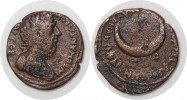
(0177) COMMODUS -- MESOPOTAMIA, CARRHAE177 - 192 AD
AE 22 mm 6.64 g
O: AVT K MANTWK[?]OCCEE (legend counterclockwise)
Commodus, Bust R
R: AVPHÃâºIéN KAPPHN æIÃâºÃ©PéM [AIéNâ¦]
Crescent, fillets tied in bows below
(no longer in collection)
UNRECORDEDlaney
|
|

(0198) CARACALLAprobably Caracalla, 198-217 AD
AE 15 mm, 3.83 g
O: head right
R: vexillum
Mesopotamia, Rhesaenalaney
|
|

(0198) CARACALLA198 - 217 AD
AE 17 X 19 mm; 5.31 g
O: Bust right, supported by eagle.
Rev: LEG-III; vexillum with star at center;
Mesopotamia, Rhesaenalaney
|
|

(0198) CARACALLA98-217 AD
AE 14.5 mm; 2.90 g
O: Laureate head of Caracalla right
R: Turreted and veiled bust of Tyche right
Mesopotamia, Carrhaelaney
|
|

(0198) CARACALLA198-217 AD
AE 17.5 mm, 8.34 g
O: Laureate head of Caracalla right
R: Turreted and veiled head of Tyche right
Mesopotamia, probably Carrhaelaney
|
|

(0198) CARACALLA (or ELAGABALUS)198 - 217 AD
AE 15 mm; 3.11 g
O: Radiate head right
R: Two Leg III vexilla, with single standard between
Mesopotamia, Rhesaena
(reverse appears to be unpublished)laney
|
|
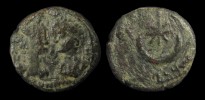
(0198) CARACALLA AND GETAca. 208 - 211 AD
AE 18.7mm, 4.45 g
O: confronted busts of laureate, draped, cuirassed Caracalla, on left: and bare-headed, draped Geta, on right.
R: star of eight rays within crescent, legend around crescent
Mesopotamia, Carrhae mint; cf. BMC p. 87, 45-8; SNG Cop -; Weber -; McClean -; very rarelaney
|
|

(02) AUGUSTUS27 BC - 14 AD, STRUCK Ca. 7 BC
AE As 28 mm 8.64 g
O:CAESAR AVGVST PONT MAX TRIBVNIC POT
BARE HHEAD L
R: M MAECILIVS TVLLVS III VIR AAA FF AROUND LARGE SClaney
|
|

(02) AUGUSTUS27 BC - 14 AD
AE 21.5 mm 4.74 g
O: AVGVSTVS TRIBVNIC POTEST in wreath
R: Legend around large SClaney
|
|

(02) AUGUSTUS27 BC - 14 AD
AE 22 mm 6.60 g
O: AVGVSTVS TRIBVNIC POTEST in wreath
R: Legend around large SClaney
|
|

(02) AUGUSTUS27 BC - 14 AD
struck ca. 7 BC
AE As 27 mm, 6.04 g
O: CAESAR AVGVST PONT MAX TRIBVNEC POT, bare head right.
R: M SALVIVS OTHO III VIR AAA F F around large S C.
cf. RIC 431
Moneyer: M. Salvius Otholaney
|
|
| 3593 files on 40 page(s) |
1 |
 |
 |
 |
 |
|

|
